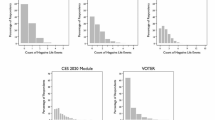Abstract
President Roosevelt's attempt to add asmany as six additional justices to theSupreme Court through his infamous``court-packing plan'' of 1937 has long beenheralded as a misuse of presidential powerthat nearly undermined the integrity of ourconstitutional system. Using an analyticnarrative framework, we offer analternative theoretical account of theevents and argue that Roosevelt used theproposal to obtain his immediate goal: ashift in policy direction of the Court. Our framework is supported with historicalevidence, suggesting that all of the actorswere acting rationally by attempting tomaximize their payoffs.
Similar content being viewed by others
References
Allison, G. (1971). Essence of decision: Explaining the cuban missile crisis. Boston: Little, Brown Co.
Alsop, J. and Catledge, T. (1938). The 168 days. Garden City: Doubleday, Doran.
Bates, R., Greif, A., Levi, M., Rosenthal, J. and Weingast, B. (1998). Analytic narratives. Princeton: Princeton University Press.
Bueno de Mesquita, B. (1981). The war trap. New Haven: Yale University Press.
Burns, J.M. (1956). Roosevelt: The lion and the fox. New York: Harcourt, Brace.
Caldeira, G. (1987). Public opinion and the U.S. Supreme Court: FDR's court-packing plan. American Political Science Review 81: 1139-1153.
Carson, J. and Kleinerman, B. (2001). Political institutions and american political development: Evolution in the size of the U.S. Supreme Court. Paper Presented at the Annual Meeting of the Midwest Political Science Association.
Clinton, R.L. (1994). Game theory, legal history, and the origins of judicial review: A revisionist analysis of Marbury v. Madison. American Journal of Political Science 38: 285-302.
Cushman, B. (1998). Rethinking the new deal court: The structure of a constitutional revolution. New York: Oxford University Press.
Danelski, D. and Tulchin, J. (1973). The autobiographical notes of Charles Evans Hughes. Cambridge: Harvard University Press.
Dixit, A. and Skeath, S. (1999). Games of strategy. New York: W.W. Norton & Company.
Freedman, M. (1967). Roosevelt and Frankfurter: Their correspondence, 1928-1945. Boston: Little, Brown Co.
Friedman, M. (1953). Essays in positive economics. Chicago: University of Chicago Press.
Gates, S. and Humes, B. (1997). Games, information, and politics: Applying game theoretic models to political science. Ann Arbor: University of Michigan Press.
Gely, R. and Spiller, P. (1992). The political economy of Supreme Court constitutional decisions: The case of Roosevelt's court-packing plan. International Review of Law and Economics 12: 45-67.
Greer, T. (1958). What Roosevelt thought: The social and political ideas of Franklin D. Roosevelt. East Lansing: Michigan State University.
Ickes, H. (1953-54). The secret diary of Harold Ickes. New York: Simon and Schuster.
Jackson, R. (1941). The struggle for judicial supremacy. New York: Alfred A. Knopf.
Jenkins, J. and Sala, B. (1998). The spatial theory of voting and the presidential election of 1824. American Journal of Political Science 42: 1157-1179.
Kiewiet, D.R. and McCubbins, M. (1991). The logic of delegation: Congressional parties and the appropriations process. Chicago: University of Chicago Press.
Krehbiel, K. (1998). Pivotal politics: A theory of U.S. lawmaking. Chicago: University of Chicago Press.
Kyvig, D. (1989). The road not taken: FDR, the Supreme Court, and constitutional amendment. Political Science Quarterly 104: 463-481.
Leuchtenburg, W. (1966). The origins of Franklin D. Roosevelt's 'court-packing' plan. In P.B. Kurland (Ed.), The Supreme Court Review, 347-400. Chicago: University of Chicago Press.
Leuchtenburg, W. (1969). Roosevelt's Supreme Court packing plan. In H.M. Hollingsworth and W.F. Holmes (Eds.), Essays on the new deal. Austin: University of Texas Press.
Leuchtenburg, W. (1995a). The Supreme Court reborn: The constitutional revolution in the age of Roosevelt. New York: Oxford University Press.
Author information
Authors and Affiliations
Rights and permissions
About this article
Cite this article
Carson, J.L., Kleinerman, B.A. A Switch in Time Saves Nine: Institutions, Strategic Actors, and FDR's Court-Packing Plan. Public Choice 113, 301–324 (2002). https://doi.org/10.1023/A:1020815625514
Issue Date:
DOI: https://doi.org/10.1023/A:1020815625514




